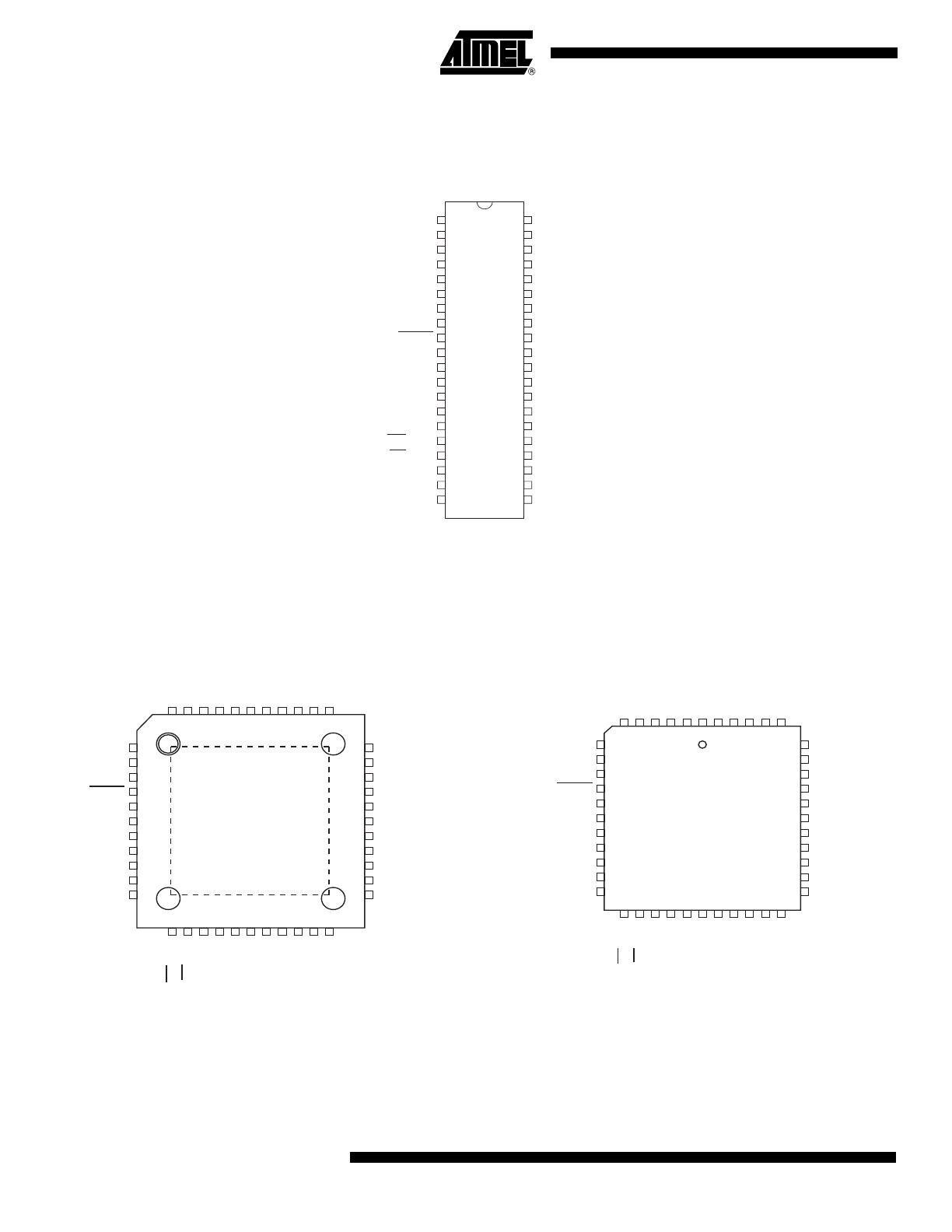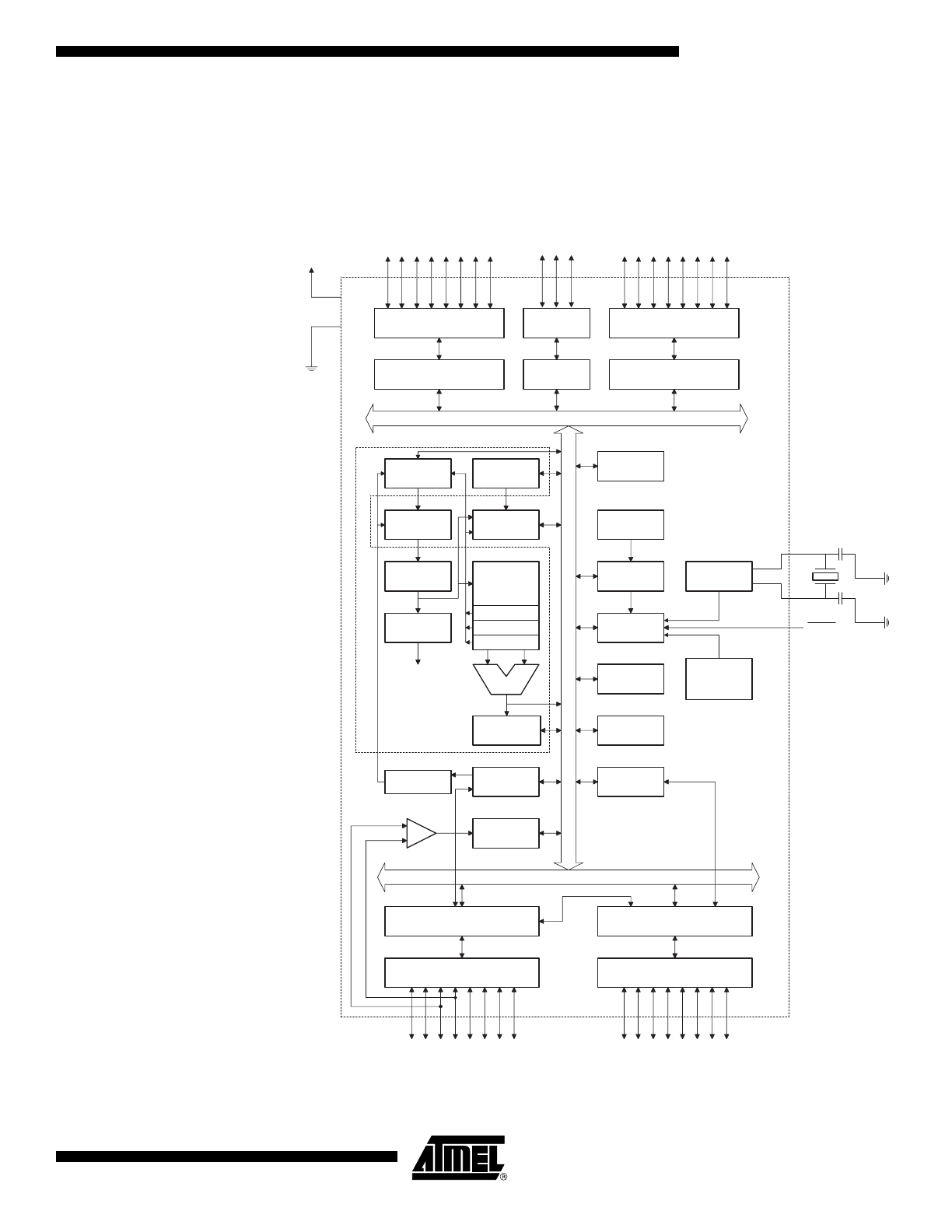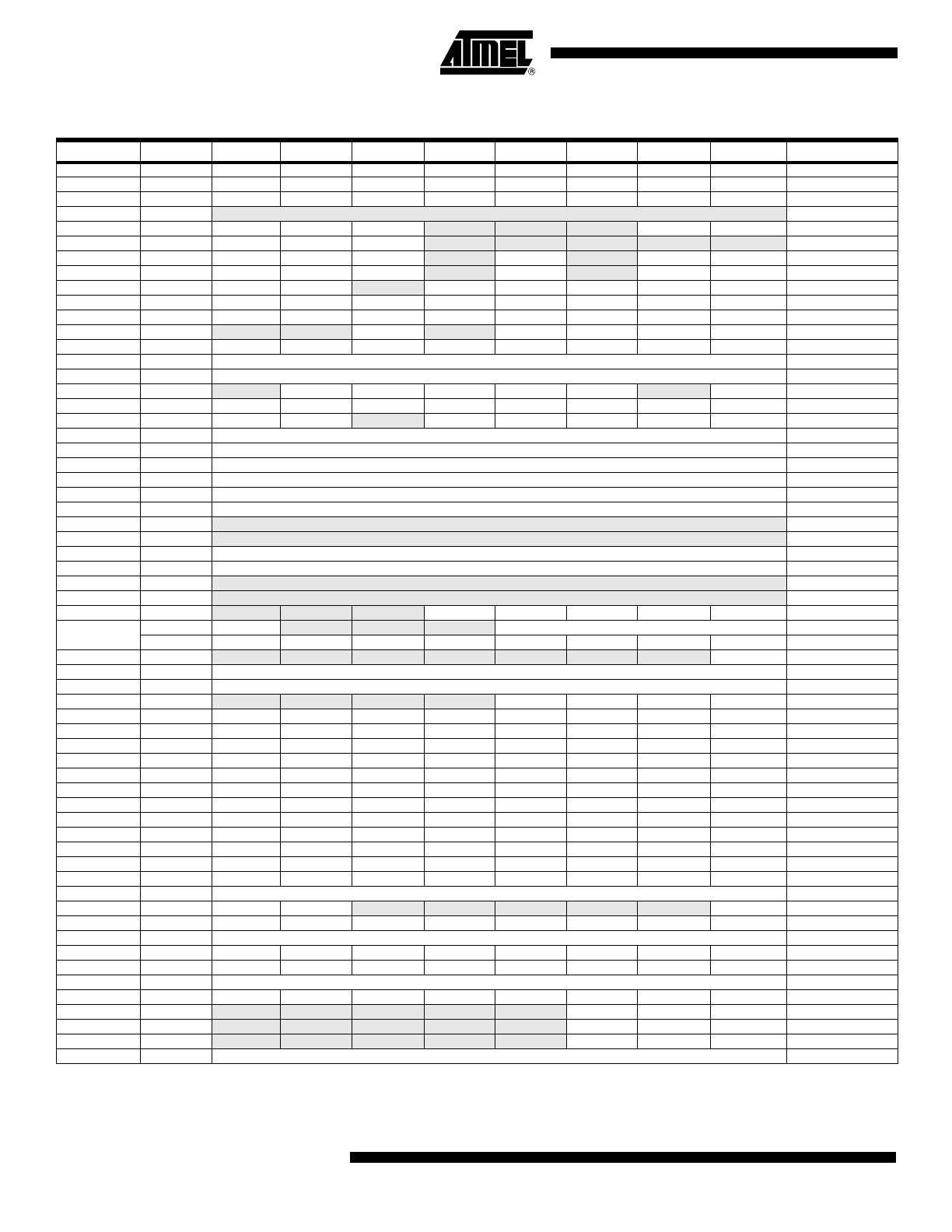
Features
•
High-performance, Low-power AVR
®
8-bit Microcontroller
•
RISC Architecture
– 130 Powerful Instructions – Most Single Clock Cycle Execution
– 32 x 8 General Purpose Working Registers
– Fully Static Operation
– Up to 16 MIPS Throughput at 16 MHz
– On-chip 2-cycle Multiplier
•
Nonvolatile Program and Data Memories
– 8K Bytes of In-System Self-programmable Flash
Endurance: 10,000 Write/Erase Cycles
– Optional Boot Code Section with Independent Lock bits
In-System Programming by On-chip Boot Program
True Read-While-Write Operation
– 512 Bytes EEPROM
Endurance: 100,000 Write/Erase Cycles
– 512 Bytes Internal SRAM
– Up to 64K Bytes Optional External Memory Space
– Programming Lock for Software Security
•
Peripheral Features
– One 8-bit Timer/Counter with Separate Prescaler and Compare Mode
– One 16-bit Timer/Counter with Separate Prescaler, Compare Mode, and Capture
Mode
– Three PWM Channels
– Programmable Serial USART
– Master/Slave SPI Serial Interface
– Programmable Watchdog Timer with Separate On-chip Oscillator
– On-chip Analog Comparator
•
Special Microcontroller Features
– Power-on Reset and Programmable Brown-out Detection
– Internal Calibrated RC Oscillator
– External and Internal Interrupt Sources
– Three Sleep Modes: Idle, Power-down and Standby
•
I/O and Packages
– 35 Programmable I/O Lines
– 40-pin PDIP, 44-lead TQFP, 44-lead PLCC, and 44-pad QFN/MLF
•
Operating Voltages
– 2.7 - 5.5V for ATmega8515L
– 4.5 - 5.5V for ATmega8515
•
Speed Grades
– 0 - 8 MHz for ATmega8515L
– 0 - 16 MHz for ATmega8515
8-bit
Microcontroller
with 8K Bytes
In-System
Programmable
Flash
ATmega8515
ATmega8515L
Summary
2512JS–AVR–10/06
Note: This is a summary document. A complete document
is available on our Web site at www.atmel.com.

2
ATmega8515(L)
2512JS–AVR–10/06
Pin Configurations
Figure 1. Pinout ATmega8515
1
2
3
4
5
6
7
8
9
10
11
12
13
14
15
16
17
18
19
20
40
39
38
37
36
35
34
33
32
31
30
29
28
27
26
25
24
23
22
21
(OC0/T0) PB0
(T1) PB1
(AIN0) PB2
(AIN1) PB3
(SS) PB4
(MOSI) PB5
(MISO) PB6
(SCK) PB7
RESET
(RXD) PD0
(TDX) PD1
(INT0) PD2
(INT1) PD3
(XCK) PD4
(OC1A) PD5
(WR) PD6
(RD) PD7
XTAL2
XTAL1
GND
VCC
PA0 (AD0)
PA1 (AD1)
PA2 (AD2)
PA3 (AD3)
PA4 (AD4)
PA5 (AD5)
PA6 (AD6)
PA7 (AD7)
PE0 (ICP/INT2)
PE1 (ALE)
PE2 (OC1B)
PC7 (A15)
PC6 (A14)
PC5 (A13)
PC4 (A12)
PC3 (A11)
PC2 (A10)
PC1 (A9)
PC0 (A8)
PDIP
1
2
3
4
5
6
7
8
9
10
11
33
32
31
30
29
28
27
26
25
24
23
(MOSI) PB5
(MISO) PB6
(SCK) PB7
RESET
(RXD) PD0
NC*
(TXD) PD1
(INT0) PD2
(INT1) PD3
(XCK) PD4
(OC1A) PD5
PA4 (AD4)
PA5 (AD5)
PA6 (AD6)
PA7 (AD7)
PE0 (ICP/INT2)
NC*
PE1 (ALE)
PE2 (OC1B)
PC7 (A15)
PC6 (A14)
PC5 (A13)
44
43
42
41
40
39
38
37
36
35
34
12
13
14
15
16
17
18
19
20
21
22
(WR) PD6
(RD) PD7
XTAL2
XTAL1
GND
NC*
(A8) PC0
(A9) PC1
(A10) PC2
(A11) PC3
(A12) PC4
PB4 (SS)
PB3 (AIN1)
PB2 (AIN0)
PB1 (T1)
PB0 (OC0/T0)
NC*
VCC
PA0 (AD0)
PA1 (AD1)
PA2 (AD2)
PA3 (AD3)
TQFP/MLF
7
8
9
10
11
12
13
14
15
16
17
39
38
37
36
35
34
33
32
31
30
29
(MOSI) PB5
(MISO) PB6
(SCK) PB7
RESET
(RXD) PD0
NC*
(TXD) PD1
(INT0) PD2
(INT1) PD3
(XCK) PD4
(OC1A) PD5
PA4 (AD4)
PA5 (AD5)
PA6 (AD6)
PA7 (AD7)
PE0 (ICP/INT2)
NC*
PE1 (ALE)
PE2 (OC1B)
PC7 (A15)
PC6 (A14)
PC5 (A13)
6
5
4
3
2
1
44
43
42
41
40
18
19
20
21
22
23
24
25
26
27
28
(WR) PD6
(RD) PD7
XTAL2
XTAL1
GND
NC*
(A8) PC0
(A9) PC1
(A10) PC2
(A11) PC3
(A12) PC4
PB4 (SS)
PB3 (AIN1)
PB2 (AIN0)
PB1 (T1)
PB0 (OC0/T0)
NC*
VCC
PA0 (AD0)
PA1 (AD1)
PA2 (AD2)
PA3 (AD3)
PLCC
NOTES:
1. MLF bottom pad should be soldered to ground.
2. * NC = Do not connect (May be used in future devices)

3
ATmega8515(L)
2512JS–AVR–10/06
Overview
The ATmega8515 is a low-power CMOS 8-bit microcontroller based on the AVR
enhanced RISC architecture. By executing powerful instructions in a single clock cycle,
the ATmega8515 achieves throughputs approaching 1 MIPS per MHz allowing the sys-
tem designer to optimize power consumption versus processing speed.
Block Diagram
Figure 2. Block Diagram
INTERNAL
OSCILLATOR
WATCHDOG
TIMER
MCU CTRL.
& TIMING
OSCILLATOR
TIMERS/
COUNTERS
INTERRUPT
UNIT
STACK
POINTER
EEPROM
SRAM
STATUS
REGISTER
USART
PROGRAM
COUNTER
PROGRAM
FLASH
INSTRUCTION
REGISTER
INSTRUCTION
DECODER
PROGRAMMING
LOGIC
SPI
COMP.
INTERFACE
PORTA DRIVERS/BUFFERS
PORTA DIGITAL INTERFACE
GENERAL
PURPOSE
REGISTERS
X
Y
Z
ALU
+
-
PORTC DRIVERS/BUFFERS
PORTC DIGITAL INTERFACE
PORTB DIGITAL INTERFACE
PORTB DRIVERS/BUFFERS
PORTD DIGITAL INTERFACE
PORTD DRIVERS/BUFFERS
XTAL1
XTAL2
RESET
CONTROL
LINES
VCC
GND
PA0 - PA7
PC0 - PC7
PD0 - PD7
PB0 - PB7
AVR CPU
INTERNAL
CALIBRATED
OSCILLATOR
PORTE
DRIVERS/
BUFFERS
PORTE
DIGITAL
INTERFACE
PE0 - PE2

4
ATmega8515(L)
2512JS–AVR–10/06
The AVR core combines a rich instruction set with 32 general purpose working registers.
All the 32 registers are directly connected to the Arithmetic Logic Unit (ALU), allowing
two independent registers to be accessed in one single instruction executed in one clock
cycle. The resulting architecture is more code efficient while achieving throughputs up to
ten times faster than conventional CISC microcontrollers.
The ATmega8515 provides the following features: 8K bytes of In-System Programmable
Flash with Read-While-Write capabilities, 512 bytes EEPROM, 512 bytes SRAM, an
External memory interface, 35 general purpose I/O lines, 32 general purpose working
registers, two flexible Timer/Counters with compare modes, Internal and External inter-
rupts, a Serial Programmable USART, a programmable Watchdog Timer with internal
Oscillator, a SPI serial port, and three software selectable power saving modes. The Idle
mode stops the CPU while allowing the SRAM, Timer/Counters, SPI port, and Interrupt
system to continue functioning. The Power-down mode saves the Register contents but
freezes the Oscillator, disabling all other chip functions until the next interrupt or hard-
ware reset. In Standby mode, the crystal/resonator Oscillator is running while the rest of
the device is sleeping. This allows very fast start-up combined with low-power
consumption.
The device is manufactured using Atmel’s high density nonvolatile memory technology.
The On-chip ISP Flash allows the Program memory to be reprogrammed In-System
through an SPI serial interface, by a conventional nonvolatile memory programmer, or
by an On-chip Boot program running on the AVR core. The boot program can use any
interface to download the application program in the Application Flash memory. Soft-
ware in the Boot Flash section will continue to run while the Application Flash section is
updated, providing true Read-While-Write operation. By combining an 8-bit RISC CPU
with In-System Self-programmable Flash on a monolithic chip, the Atmel ATmega8515
is a powerful microcontroller that provides a highly flexible and cost effective solution to
many embedded control applications.
The ATmega8515 is supported with a full suite of program and system development
tools including: C Compilers, Macro assemblers, Program debugger/simulators, In-cir-
cuit Emulators, and Evaluation kits.
Disclaimer
Typical values contained in this datasheet are based on simulations and characteriza-
tion of other AVR microcontrollers manufactured on the same process technology. Min
and Max values will be available after the device is characterized.
AT90S4414/8515 and
ATmega8515
Compatibility
The ATmega8515 provides all the features of the AT90S4414/8515. In addition, several
n e w f e a t u r e s a r e a d d e d . T h e A T m e g a 8 5 1 5 i s b a c k w a r d c o m p a t i b l e w i t h
AT90S4414/8515 in most cases. However, some incompatibilities between the two
microcontrollers exist. To solve this problem, an AT90S4414/8515 compatibility mode
can be selected by programming the S8515C Fuse. ATmega8515 is 100% pin compati-
ble with AT90S4414/8515, and can replace the AT90S4414/8515 on current printed
circuit boards. However, the location of Fuse bits and the electrical characteristics dif-
fers between the two devices.
AT90S4414/8515 Compatibility
Mode
Programming the S8515C Fuse will change the following functionality:
•
The timed sequence for changing the Watchdog Time-out period is disabled. See
“Timed Sequences for Changing the Configuration of the Watchdog Timer” on page
53 for details.
•
The double buffering of the USART Receive Registers is disabled. See “AVR
USART vs. AVR UART – Compatibility” on page 137 for details.
•
PORTE(2:1) will be set as output, and PORTE0 will be set as input.

5
ATmega8515(L)
2512JS–AVR–10/06
Pin Descriptions
VCC
Digital supply voltage.
GND
Ground.
Port A (PA7..PA0)
Port A is an 8-bit bi-directional I/O port with internal pull-up resistors (selected for each
bit). The Port A output buffers have symmetrical drive characteristics with both high sink
and source capability. When pins PA0 to PA7 are used as inputs and are externally
pulled low, they will source current if the internal pull-up resistors are activated. The Port
A pins are tri-stated when a reset condition becomes active, even if the clock is not
running.
Port A also serves the functions of various special features of the ATmega8515 as listed
on page 67.
Port B (PB7..PB0)
Port B is an 8-bit bi-directional I/O port with internal pull-up resistors (selected for each
bit). The Port B output buffers have symmetrical drive characteristics with both high sink
and source capability. As inputs, Port B pins that are externally pulled low will source
current if the pull-up resistors are activated. The Port B pins are tri-stated when a reset
condition becomes active, even if the clock is not running.
Port B also serves the functions of various special features of the ATmega8515 as listed
on page 67.
Port C (PC7..PC0)
Port C is an 8-bit bi-directional I/O port with internal pull-up resistors (selected for each
bit). The Port C output buffers have symmetrical drive characteristics with both high sink
and source capability. As inputs, Port C pins that are externally pulled low will source
current if the pull-up resistors are activated. The Port C pins are tri-stated when a reset
condition becomes active, even if the clock is not running.
Port D (PD7..PD0)
Port D is an 8-bit bi-directional I/O port with internal pull-up resistors (selected for each
bit). The Port D output buffers have symmetrical drive characteristics with both high sink
and source capability. As inputs, Port D pins that are externally pulled low will source
current if the pull-up resistors are activated. The Port D pins are tri-stated when a reset
condition becomes active, even if the clock is not running.
Port D also serves the functions of various special features of the ATmega8515 as listed
on page 72.
Port E(PE2..PE0)
Port E is an 3-bit bi-directional I/O port with internal pull-up resistors (selected for each
bit). The Port E output buffers have symmetrical drive characteristics with both high sink
and source capability. As inputs, Port E pins that are externally pulled low will source
current if the pull-up resistors are activated. The Port E pins are tri-stated when a reset
condition becomes active, even if the clock is not running.
Port E also serves the functions of various special features of the ATmega8515 as listed
on page 74.
RESET
Reset input. A low level on this pin for longer than the minimum pulse length will gener-
ate a reset, even if the clock is not running. The minimum pulse length is given in Table
18 on page 46. Shorter pulses are not guaranteed to generate a reset.
XTAL1
Input to the inverting Oscillator amplifier and input to the internal clock operating circuit.
XTAL2
Output from the inverting Oscillator amplifier.

6
ATmega8515(L)
2512JS–AVR–10/06
Resources
A comprehensive set of development tools, application notes and datasheets are avail-
able for download on http://www.atmel.com/avr.

7
ATmega8515(L)
2512JS–AVR–10/06
About Code
Examples
This documentation contains simple code examples that briefly show how to use various
parts of the device. These code examples assume that the part specific header file is
included before compilation. Be aware that not all C Compiler vendors include bit defini-
tions in the header files and interrupt handling in C is compiler dependent. Please
confirm with the C Compiler documentation for more details.

8
ATmega8515(L)
2512JS–AVR–10/06
Register Summary
Notes:
1. Refer to the USART description for details on how to access UBRRH and UCSRC.
2. For compatibility with future devices, reserved bits should be written to zero if accessed. Reserved I/O memory addresses
should never be written.
Address
Name
Bit 7
Bit 6
Bit 5
Bit 4
Bit 3
Bit 2
Bit 1
Bit 0
Page
$3F ($5F)
SREG
I
T
H
S
V
N
Z
C
10
$3E ($5E)
SPH
SP15
SP14
SP13
SP12
SP11
SP10
SP9
SP8
12
$3D ($5D)
SPL
SP7
SP6
SP5
SP4
SP3
SP2
SP1
SP0
12
$3C ($5C)
Reserved
-
$3B ($5B)
GICR
INT1
INT0
INT2
-
-
-
IVSEL
IVCE
57, 78
$3A ($5A)
GIFR
INTF1
INTF0
INTF2
-
-
-
-
-
79
$39 ($59)
TIMSK
TOIE1
OCIE1A
OCIE1B
-
TICIE1
-
TOIE0
OCIE0
93, 124
$38 ($58)
TIFR
TOV1
OCF1A
OCF1B
-
ICF1
-
TOV0
OCF0
93, 125
$37 ($57)
SPMCR
SPMIE
RWWSB
-
RWWSRE
BLBSET
PGWRT
PGERS
SPMEN
170
$36 ($56)
EMCUCR
SM0
SRL2
SRL1
SRL0
SRW01
SRW00
SRW11
ISC2
29,42,78
$35 ($55)
MCUCR
SRE
SRW10
SE
SM1
ISC11
ISC10
ISC01
ISC00
29,41,77
$34 ($54)
MCUCSR
-
-
SM2
-
WDRF
BORF
EXTRF
PORF
41,49
$33 ($53)
TCCR0
FOC0
WGM00
COM01
COM00
WGM01
CS02
CS01
CS00
91
$32 ($52)
TCNT0
Timer/Counter0 (8 Bits)
93
$31 ($51)
OCR0
Timer/Counter0 Output Compare Register
93
$30 ($50)
SFIOR
-
XMBK
XMM2
XMM1
XMM0
PUD
-
PSR10
31,66,96
$2F ($4F)
TCCR1A
COM1A1
COM1A0
COM1B1
COM1B0
FOC1A
FOC1B
WGM11
WGM10
119
$2E ($4E)
TCCR1B
ICNC1
ICES1
-
WGM13
WGM12
CS12
CS11
CS10
122
$2D ($4D)
TCNT1H
Timer/Counter1 - Counter Register High Byte
123
$2C ($4C)
TCNT1L
Timer/Counter1 - Counter Register Low Byte
123
$2B ($4B)
OCR1AH
Timer/Counter1 - Output Compare Register A High Byte
123
$2A ($4A)
OCR1AL
Timer/Counter1 - Output Compare Register A Low Byte
123
$29 ($49)
OCR1BH
Timer/Counter1 - Output Compare Register B High Byte
123
$28 ($48)
OCR1BL
Timer/Counter1 - Output Compare Register B Low Byte
123
$27 ($47)
Reserved
-
-
$26 ($46)
Reserved
-
-
$25 ($45)
ICR1H
Timer/Counter1 - Input Capture Register High Byte
124
$24 ($44)
ICR1L
Timer/Counter1 - Input Capture Register Low Byte
124
$23 ($43)
Reserved
-
-
$22 ($42)
Reserved
-
-
$21 ($41)
WDTCR
-
-
-
WDCE
WDE
WDP2
WDP1
WDP0
51
$20
(1)
($40)
(1)
UBRRH
URSEL
-
-
-
UBRR[11:8]
159
UCSRC
URSEL
UMSEL
UPM1
UPM0
USBS
UCSZ1
UCSZ0
UCPOL
157
$1F ($3F)
EEARH
-
-
-
-
-
-
-
EEAR8
19
$1E ($3E)
EEARL
EEPROM Address Register Low Byte
19
$1D ($3D)
EEDR
EEPROM Data Register
20
$1C ($3C)
EECR
-
-
-
-
EERIE
EEMWE
EEWE
EERE
20
$1B ($3B)
PORTA
PORTA7
PORTA6
PORTA5
PORTA4
PORTA3
PORTA2
PORTA1
PORTA0
75
$1A ($3A)
DDRA
DDA7
DDA6
DDA5
DDA4
DDA3
DDA2
DDA1
DDA0
75
$19 ($39)
PINA
PINA7
PINA6
PINA5
PINA4
PINA3
PINA2
PINA1
PINA0
75
$18 ($38)
PORTB
PORTB7
PORTB6
PORTB5
PORTB4
PORTB3
PORTB2
PORTB1
PORTB0
75
$17 ($37)
DDRB
DDB7
DDB6
DDB5
DDB4
DDB3
DDB2
DDB1
DDB0
75
$16 ($36)
PINB
PINB7
PINB6
PINB5
PINB4
PINB3
PINB2
PINB1
PINB0
75
$15 ($35)
PORTC
PORTC7
PORTC6
PORTC5
PORTC4
PORTC3
PORTC2
PORTC1
PORTC0
75
$14 ($34)
DDRC
DDC7
DDC6
DDC5
DDC4
DDC3
DDC2
DDC1
DDC0
75
$13 ($33)
PINC
PINC7
PINC6
PINC5
PINC4
PINC3
PINC2
PINC1
PINC0
76
$12 ($32)
PORTD
PORTD7
PORTD6
PORTD5
PORTD4
PORTD3
PORTD2
PORTD1
PORTD0
76
$11 ($31)
DDRD
DDD7
DDD6
DDD5
DDD4
DDD3
DDD2
DDD1
DDD0
76
$10 ($30)
PIND
PIND7
PIND6
PIND5
PIND4
PIND3
PIND2
PIND1
PIND0
76
$0F ($2F)
SPDR
SPI Data Register
133
$0E ($2E)
SPSR
SPIF
WCOL
-
-
-
-
-
SPI2X
133
$0D ($2D)
SPCR
SPIE
SPE
DORD
MSTR
CPOL
CPHA
SPR1
SPR0
131
$0C ($2C)
UDR
USART I/O Data Register
155
$0B ($2B)
UCSRA
RXC
TXC
UDRE
FE
DOR
PE
U2X
MPCM
155
$0A ($2A)
UCSRB
RXCIE
TXCIE
UDRIE
RXEN
TXEN
UCSZ2
RXB8
TXB8
156
$09 ($29)
UBRRL
USART Baud Rate Register Low Byte
159
$08 ($28)
ACSR
ACD
ACBG
ACO
ACI
ACIE
ACIC
ACIS1
ACIS0
164
$07 ($27)
PORTE
-
-
-
-
-
PORTE2
PORTE1
PORTE0
76
$06 ($26)
DDRE
-
-
-
-
-
DDE2
DDE1
DDE0
76
$05 ($25)
PINE
-
-
-
-
-
PINE2
PINE1
PINE0
76
$04 ($24)
OSCCAL
Oscillator Calibration Register
39

9
ATmega8515(L)
2512JS–AVR–10/06
3. Some of the Status Flags are cleared by writing a logical one to them. Note that the CBI and SBI instructions will operate on
all bits in the I/O Register, writing a one back into any flag read as set, thus clearing the flag. The CBI and SBI instructions
work with registers $00 to $1F only.

10
ATmega8515(L)
2512JS–AVR–10/06
Instruction Set Summary
Mnemonics
Operands
Description
Operation
Flags
#Clocks
ARITHMETIC AND LOGIC INSTRUCTIONS
ADD
Rd, Rr
Add two Registers
Rd
← Rd + Rr
Z,C,N,V,H
1
ADC
Rd, Rr
Add with Carry two Registers
Rd
← Rd + Rr + C
Z,C,N,V,H
1
ADIW
Rdl,K
Add Immediate to Word
Rdh:Rdl
← Rdh:Rdl + K
Z,C,N,V,S
2
SUB
Rd, Rr
Subtract two Registers
Rd
← Rd - Rr
Z,C,N,V,H
1
SUBI
Rd, K
Subtract Constant from Register
Rd
← Rd - K
Z,C,N,V,H
1
SBC
Rd, Rr
Subtract with Carry two Registers
Rd
← Rd - Rr - C
Z,C,N,V,H
1
SBCI
Rd, K
Subtract with Carry Constant from Reg.
Rd
← Rd - K - C
Z,C,N,V,H
1
SBIW
Rdl,K
Subtract Immediate from Word
Rdh:Rdl
← Rdh:Rdl - K
Z,C,N,V,S
2
AND
Rd, Rr
Logical AND Registers
Rd
← Rd • Rr
Z,N,V
1
ANDI
Rd, K
Logical AND Register and Constant
Rd
← Rd • K
Z,N,V
1
OR
Rd, Rr
Logical OR Registers
Rd
← Rd v Rr
Z,N,V
1
ORI
Rd, K
Logical OR Register and Constant
Rd
← Rd v K
Z,N,V
1
EOR
Rd, Rr
Exclusive OR Registers
Rd
← Rd ⊕ Rr
Z,N,V
1
COM
Rd
One’s Complement
Rd
← $FF − Rd
Z,C,N,V
1
NEG
Rd
Two’s Complement
Rd
← $00 − Rd
Z,C,N,V,H
1
SBR
Rd,K
Set Bit(s) in Register
Rd
← Rd v K
Z,N,V
1
CBR
Rd,K
Clear Bit(s) in Register
Rd
← Rd • ($FF - K)
Z,N,V
1
INC
Rd
Increment
Rd
← Rd + 1
Z,N,V
1
DEC
Rd
Decrement
Rd
← Rd − 1
Z,N,V
1
TST
Rd
Test for Zero or Minus
Rd
← Rd • Rd
Z,N,V
1
CLR
Rd
Clear Register
Rd
← Rd ⊕ Rd
Z,N,V
1
SER
Rd
Set Register
Rd
← $FF
None
1
MUL
Rd, Rr
Multiply Unsigned
R1:R0
← Rd x Rr
Z,C
2
MULS
Rd, Rr
Multiply Signed
R1:R0
← Rd x Rr
Z,C
2
MULSU
Rd, Rr
Multiply Signed with Unsigned
R1:R0
← Rd x Rr
Z,C
2
FMUL
Rd, Rr
Fractional Multiply Unsigned
R1:R0
← (Rd x Rr)
<< 1
Z,C
2
FMULS
Rd, Rr
Fractional Multiply Signed
R1:R0
← (Rd x Rr)
<< 1
Z,C
2
FMULSU
Rd, Rr
Fractional Multiply Signed with Unsigned
R1:R0
← (Rd x Rr)
<< 1
Z,C
2
BRANCH INSTRUCTIONS
RJMP
k
Relative Jump
PC
← PC + k + 1
None
2
IJMP
Indirect Jump to (Z)
PC
← Z
None
2
RCALL
k
Relative Subroutine Call
PC
← PC + k + 1
None
3
ICALL
Indirect Call to (Z)
PC
← Z
None
3
RET
Subroutine Return
PC
← STACK
None
4
RETI
Interrupt Return
PC
← STACK
I
4
CPSE
Rd,Rr
Compare, Skip if Equal
if (Rd = Rr) PC
← PC + 2 or 3
None
1/2/3
CP
Rd,Rr
Compare
Rd
− Rr
Z, N,V,C,H
1
CPC
Rd,Rr
Compare with Carry
Rd
− Rr − C
Z, N,V,C,H
1
CPI
Rd,K
Compare Register with Immediate
Rd
− K
Z, N,V,C,H
1
SBRC
Rr, b
Skip if Bit in Register Cleared
if (Rr(b)=0) PC
← PC + 2 or 3
None
1/2/3
SBRS
Rr, b
Skip if Bit in Register is Set
if (Rr(b)=1) PC
← PC + 2 or 3
None
1/2/3
SBIC
P, b
Skip if Bit in I/O Register Cleared
if (P(b)=0) PC
← PC + 2 or 3
None
1/2/3
SBIS
P, b
Skip if Bit in I/O Register is Set
if (P(b)=1) PC
← PC + 2 or 3
None
1/2/3
BRBS
s, k
Branch if Status Flag Set
if (SREG(s) = 1) then PC
←PC+k + 1
None
1/2
BRBC
s, k
Branch if Status Flag Cleared
if (SREG(s) = 0) then PC
←PC+k + 1
None
1/2
BREQ
k
Branch if Equal
if (Z = 1) then PC
← PC + k + 1
None
1/2
BRNE
k
Branch if Not Equal
if (Z = 0) then PC
← PC + k + 1
None
1/2
BRCS
k
Branch if Carry Set
if (C = 1) then PC
← PC + k + 1
None
1/2
BRCC
k
Branch if Carry Cleared
if (C = 0) then PC
← PC + k + 1
None
1/2
BRSH
k
Branch if Same or Higher
if (C = 0) then PC
← PC + k + 1
None
1/2
BRLO
k
Branch if Lower
if (C = 1) then PC
← PC + k + 1
None
1/2
BRMI
k
Branch if Minus
if (N = 1) then PC
← PC + k + 1
None
1/2
BRPL
k
Branch if Plus
if (N = 0) then PC
← PC + k + 1
None
1/2
BRGE
k
Branch if Greater or Equal, Signed
if (N
⊕ V= 0) then PC ← PC + k + 1
None
1/2
BRLT
k
Branch if Less Than Zero, Signed
if (N
⊕ V= 1) then PC ← PC + k + 1
None
1/2
BRHS
k
Branch if Half Carry Flag Set
if (H = 1) then PC
← PC + k + 1
None
1/2
BRHC
k
Branch if Half Carry Flag Cleared
if (H = 0) then PC
← PC + k + 1
None
1/2
BRTS
k
Branch if T Flag Set
if (T = 1) then PC
← PC + k + 1
None
1/2
BRTC
k
Branch if T Flag Cleared
if (T = 0) then PC
← PC + k + 1
None
1/2
BRVS
k
Branch if Overflow Flag is Set
if (V = 1) then PC
← PC + k + 1
None
1/2
BRVC
k
Branch if Overflow Flag is Cleared
if (V = 0) then PC
← PC + k + 1
None
1/2
BRIE
k
Branch if Interrupt Enabled
if ( I = 1) then PC
← PC + k + 1
None
1/2
BRID
k
Branch if Interrupt Disabled
if ( I = 0) then PC
← PC + k + 1
None
1/2
